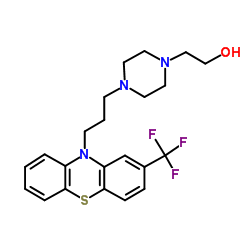Fluphenazine

Fluphenazine structure
|
Common Name | Fluphenazine | ||
|---|---|---|---|---|
| CAS Number | 69-23-8 | Molecular Weight | 437.522 | |
| Density | 1.3±0.1 g/cm3 | Boiling Point | 568.3±50.0 °C at 760 mmHg | |
| Molecular Formula | C22H26F3N3OS | Melting Point | 268-274℃ | |
| MSDS | N/A | Flash Point | 297.5±30.1 °C | |
| Symbol |



GHS02, GHS06, GHS08 |
Signal Word | Danger | |
|
Adherence challenges and long-acting injectable antipsychotic treatment in patients with schizophrenia.
J. Psychosoc. Nurs. Ment. Health Serv. 51(3) , 13-8, (2013) Medication nonadherence has been associated with persistence of psychotic symptoms, relapse, and hospitalization in patients with schizophrenia. Patients with untreated psychosis are significantly less likely to achieve remission, whereas antipsychotic drug a... |
|
|
Latent inhibition in an insect: the role of aminergic signaling.
Learn. Mem. 19(12) , 593-7, (2012) Latent inhibition (LI) is a decrement in learning performance that results from the nonreinforced pre-exposure of the to-be-conditioned stimulus, in both vertebrates and invertebrates. In vertebrates, LI development involves dopamine and serotonin; in inverte... |
|
|
[Copper intoxication decreases lifespan and induces neurologic alterations in Drosophila melanogaster].
Invest. Clin. 54(1) , 47-57, (2013) Wilson disease is a hereditary disorder caused by mutations of the ATP7B gene, which leads to intoxication with copper as a result of an unbalance of copper homeostasis. The clinical manifestations resulting from this intoxication are related to the affectati... |
|
|
Perphenazine suspension: a new, old treatment, side effects and continuous use.
Psychiatr. Q. 83(3) , 335-41, (2012) A number of innovative delivery systems for acute antipsychotic pharmacotherapy have been developed over the years which include oral suspensions, rapidly dissolving wafers and acute intramuscular preparations. Currently, the availability of first generation ... |
|
|
Attentional and emotional functioning in schizophrenia patients treated with conventional and atypical antipsychotic drugs.
Med. Sci. Monit. 18(1) , CR44-49, (2012) Effectiveness of antipsychotics in treating emotional and cognitive deficits in schizophrenia still remains controversial. The aim of our study was to assess emotional and cognitive functioning in schizophrenic inpatients currently treated with typical antips... |
|
|
Ten year outcomes of outpatients with schizophrenia on conventional depot antipsychotics: a systematic chart review.
Int. Clin. Psychopharmacol. 28(5) , 261-6, (2013) Long-term follow-up data of patients with schizophrenia on depot antipsychotics have been few and the longest follow-up period has been up to 7 years. We carried out a systematic chart review to examine 10-year outcomes for outpatients with schizophrenia who ... |
|
|
Effectiveness of switching from long-acting injectable fluphenazine or haloperidol decanoate to long-acting injectable risperidone microspheres: an open-label, randomized controlled trial.
J. Clin. Psychiatry 73(5) , 669-75, (2012) This multisite randomized trial addressed risks and benefits of staying on long-acting injectable haloperidol or fluphenazine versus switching to long-acting injectable risperidone microspheres.From December 2004 through March 2008, adult outpatients with a S... |
|
|
Treatment of schizophrenia with depot preparations of fluphenazine, haloperidol, and risperidone among inpatients at state-operated psychiatric facilities.
Schizophr. Res. 119(1-3) , 153-9, (2010) This study aimed to characterize the inpatient utilization of depot antipsychotics.The characteristics of adults with schizophrenia or schizoaffective disorder, hospitalized for at least 28 days, and who were prescribed depot antipsychotics were examined from... |
|
|
Styryl-based and tricyclic compounds as potential anti-prion agents.
PLoS ONE 6(9) , e24844, (2011) Prion diseases currently have no effective therapy. These illnesses affect both animal and human populations, and are characterized by the conformational change of a normal self protein PrP(C) (C for cellular) to a pathological and infectious conformer, PrP(S... |
|
|
Automated high-content live animal drug screening using C. elegans expressing the aggregation prone serpin α1-antitrypsin Z.
PLoS ONE 5(11) , e15460, (2010) The development of preclinical models amenable to live animal bioactive compound screening is an attractive approach to discovering effective pharmacological therapies for disorders caused by misfolded and aggregation-prone proteins. In general, however, live... |